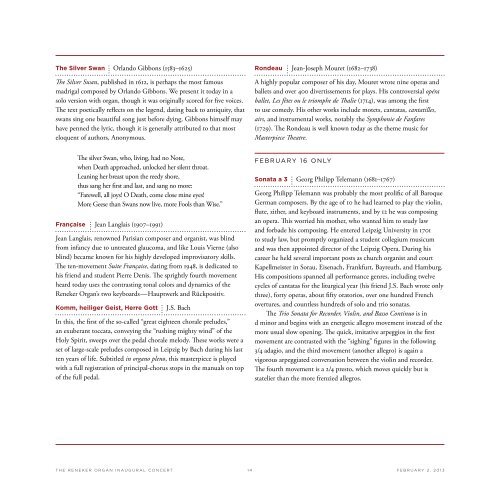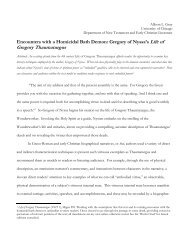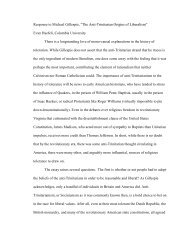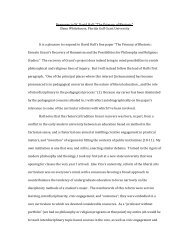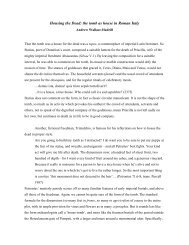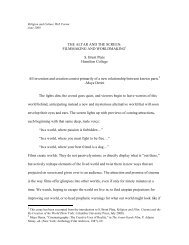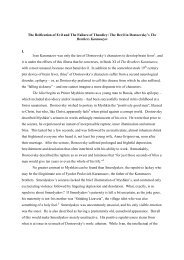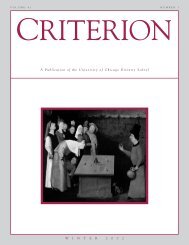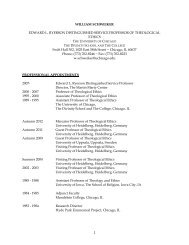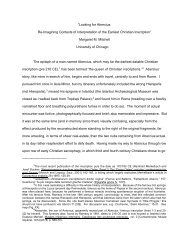Click here - Divinity School - University of Chicago
Click here - Divinity School - University of Chicago
Click here - Divinity School - University of Chicago
Create successful ePaper yourself
Turn your PDF publications into a flip-book with our unique Google optimized e-Paper software.
The Silver Swan Orlando Gibbons (1583–1625)<br />
The Silver Swan, published in 1612, is perhaps the most famous<br />
madrigal composed by Orlando Gibbons. We present it today in a<br />
solo version with organ, though it was originally scored for five voices.<br />
The text poetically reflects on the legend, dating back to antiquity, that<br />
swans sing one beautiful song just before dying. Gibbons himself may<br />
have penned the lyric, though it is generally attributed to that most<br />
eloquent <strong>of</strong> authors, Anonymous.<br />
Rondeau Jean-Joseph Mouret (1682–1738)<br />
A highly popular composer <strong>of</strong> his day, Mouret wrote nine operas and<br />
ballets and over 400 divertissements for plays. His controversial opéra<br />
ballet, Les fêtes ou le triomphe de Thalie (1714), was among the first<br />
to use comedy. His other works include motets, cantatas, cantatilles,<br />
airs, and instrumental works, notably the Symphonie de Fanfares<br />
(1729). The Rondeau is well known today as the theme music for<br />
Masterpiece Theatre.<br />
The silver Swan, who, living, had no Note,<br />
when Death approached, unlocked her silent throat.<br />
Leaning her breast upon the reedy shore,<br />
thus sang her first and last, and sang no more:<br />
“Farewell, all joys! O Death, come close mine eyes!<br />
More Geese than Swans now live, more Fools than Wise.”<br />
Française Jean Langlais (1907–1991)<br />
Jean Langlais, renowned Parisian composer and organist, was blind<br />
from infancy due to untreated glaucoma, and like Louis Vierne (also<br />
blind) became known for his highly developed improvisatory skills.<br />
The ten-movement Suite Française, dating from 1948, is dedicated to<br />
his friend and student Pierre Denis. The sprightly fourth movement<br />
heard today uses the contrasting tonal colors and dynamics <strong>of</strong> the<br />
Reneker Organ’s two keyboards—Hauptwerk and Rückpositiv.<br />
Komm, heiliger Geist, Herre Gott<br />
J.S. Bach<br />
In this, the first <strong>of</strong> the so-called “great eighteen chorale preludes,”<br />
an exuberant toccata, conveying the “rushing mighty wind” <strong>of</strong> the<br />
Holy Spirit, sweeps over the pedal chorale melody. These works were a<br />
set <strong>of</strong> large-scale preludes composed in Leipzig by Bach during his last<br />
ten years <strong>of</strong> life. Subtitled in organo pleno, this masterpiece is played<br />
with a full registration <strong>of</strong> principal-chorus stops in the manuals on top<br />
<strong>of</strong> the full pedal.<br />
FEBRUARY 16 O N LY<br />
Sonata a 3 Georg Philipp Telemann (1681–1767)<br />
Georg Philipp Telemann was probably the most prolific <strong>of</strong> all Baroque<br />
German composers. By the age <strong>of</strong> 10 he had learned to play the violin,<br />
flute, zither, and keyboard instruments, and by 12 he was composing<br />
an opera. This worried his mother, who wanted him to study law<br />
and forbade his composing. He entered Leipzig <strong>University</strong> in 1701<br />
to study law, but promptly organized a student collegium musicum<br />
and was then appointed director <strong>of</strong> the Leipzig Opera. During his<br />
career he held several important posts as church organist and court<br />
Kapellmeister in Sorau, Eisenach, Frankfurt, Bayreuth, and Hamburg.<br />
His compositions spanned all performance genres, including twelve<br />
cycles <strong>of</strong> cantatas for the liturgical year (his friend J.S. Bach wrote only<br />
three), forty operas, about fifty oratorios, over one hundred French<br />
overtures, and countless hundreds <strong>of</strong> solo and trio sonatas.<br />
The Trio Sonata for Recorder, Violin, and Basso Continuo is in<br />
d minor and begins with an energetic allegro movement instead <strong>of</strong> the<br />
more usual slow opening. The quick, imitative arpeggios in the first<br />
movement are contrasted with the “sighing” figures in the following<br />
3/4 adagio, and the third movement (another allegro) is again a<br />
vigorous arpeggiated conversation between the violin and recorder.<br />
The fourth movement is a 2/4 presto, which moves quickly but is<br />
statelier than the more frenzied allegros.<br />
THE RENEKER OR GAN INAUGUR AL CO N C E RT 14 FEBR UAR Y 2, 2013


